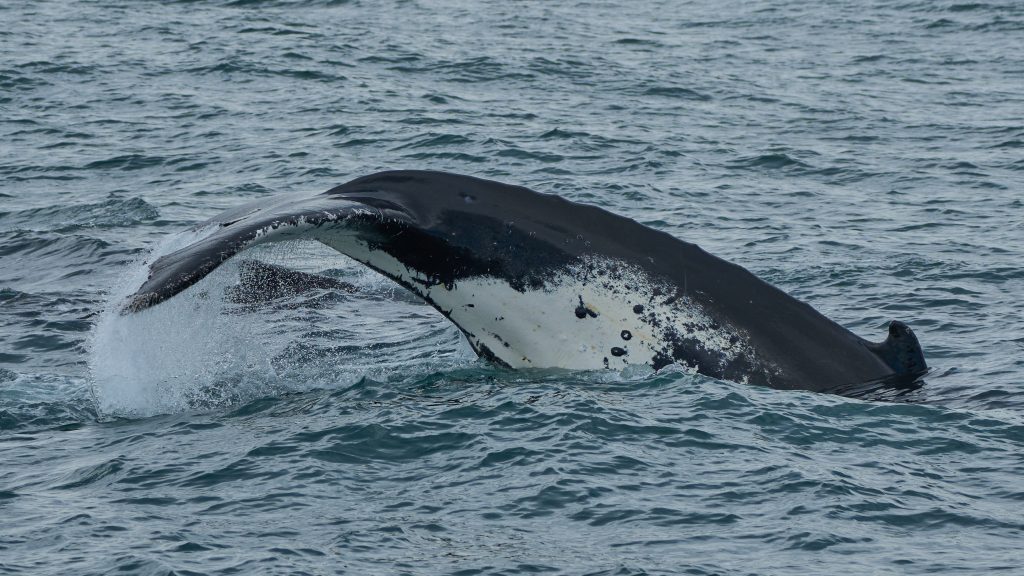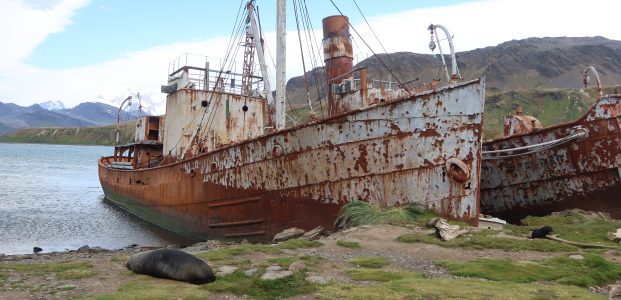Today was punctuated by whales – humpback whales. The first encounter came when we left Husvik after breakfast. Heading along the coast we spotted several pods of whales. The humpbacks have a distinctive blow, quite low and diffuse in nature, and as we looked around we spotted them astern and inshore of us. The group inshore were quite close to the cliffs and seemed to be feeding. This was confirmed when we saw a large gaping mouth appear from underwater! We watched them diving and saw the distinctive white back to the tail flukes – apparently distinctive enough that whales can be individually identified from them, kind of like a whale fingerprint. This carried on for about 15 minutes and we even had to slow down occasionally to avoid whales in front of us. Wildlife has right of way round here ….
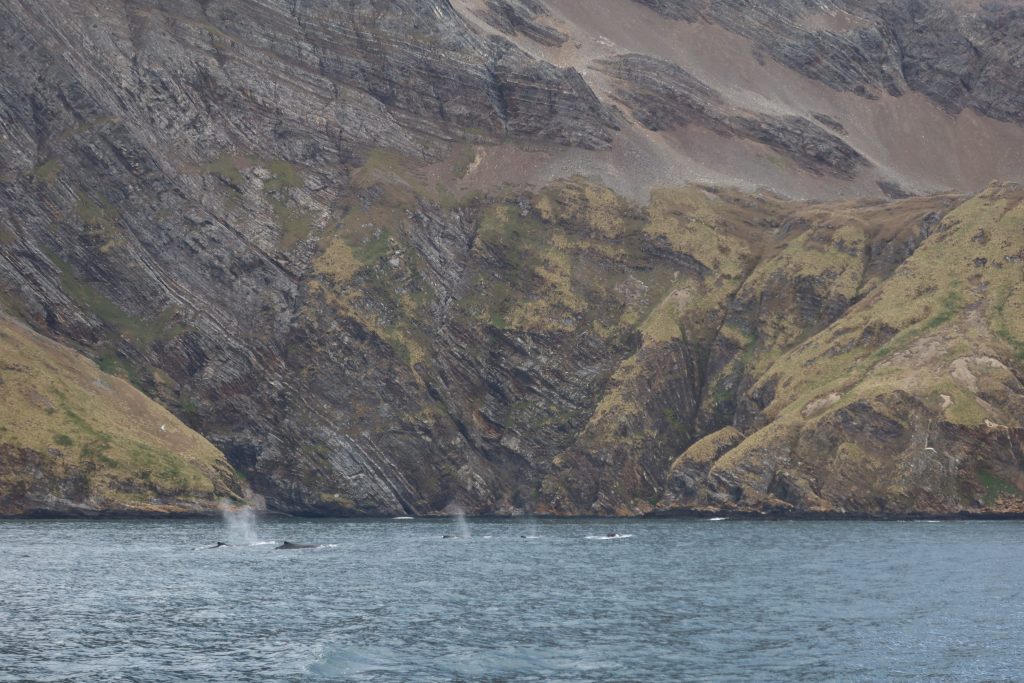
We then carried on round past King Edward Point and into Grytviken. This is another old whaling station and is probably the only inhabited place on South Georgia. The British Antarctic Survey have a base here and there is also a museum (with gift shop!) and post office. It is the only whaling station which you can walk around as well. Debris has been removed and the remaining structures have been made safe, so it is possible to get a sense of what the whaling station was actually like.
However, before we could go ashore we had to be checked in by South Georgia government officials. They also carried out a bio-security audit, checking all our gear and that we had cleaned it properly as well as checking our procedures. We passed, so we were allowed ashore. Initially we headed ashore in the Zodiac and while we were wandering around Gijs and Jet brought the boat alongside the jetty to take on water.
I started in the post office and sent postcards home and then headed for the museum. This had an excellent section on Shackleton’s Quest expedition; the one following the Endurance expedition. This was intended to be a scientific expedition and seemed to have various mixed objectives, but it is remembered best for the fact that Shackleton died shortly after he arrived in South Georgia. Initially his body was shipped to Buenos Aires, but there they received a telegram from his wife saying that he had wanted to be buried on South Georgia and so he was shipped back again and buried in the cemetery at Grytviken. The sailors on the Quest put up a memorial cross on King Edward Point opposite the cemetery where he is now buried. The museum also had lots of information about the history of whaling on South Georgia; a history that tells us a lot about human ingenuity and endurance, but also a total lack of appreciation for the impact they were having. A triumph of economic incentives over sustainability.
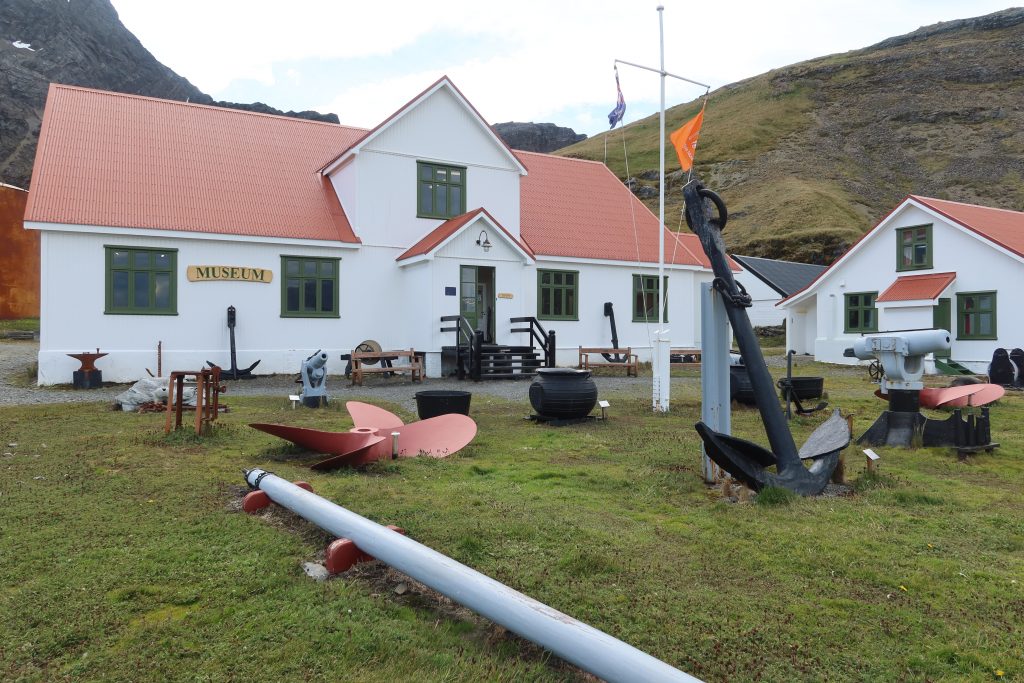
In a separate room of the museum was a maritime exhibition and the centrepiece of this is a replica of the James Caird. This replica was built in Massachusetts and used for the filming of “Shackleton’s Antarctic Adventure”, an iMax movie. It was then purchased by the South Georgia Heritage Trust in 2007 and moved to the museum. Seeing the boat once again brings home the enormity of what they achieved. There was scarcely room for one person in the cockpit and yet six of them sailed the boat, sheltering under the covered deck sleeping on stones which were being used to improve the ballasting of the boat for the seas they would face. Cooking what little they had would have been a near impossible task, yet they managed ….
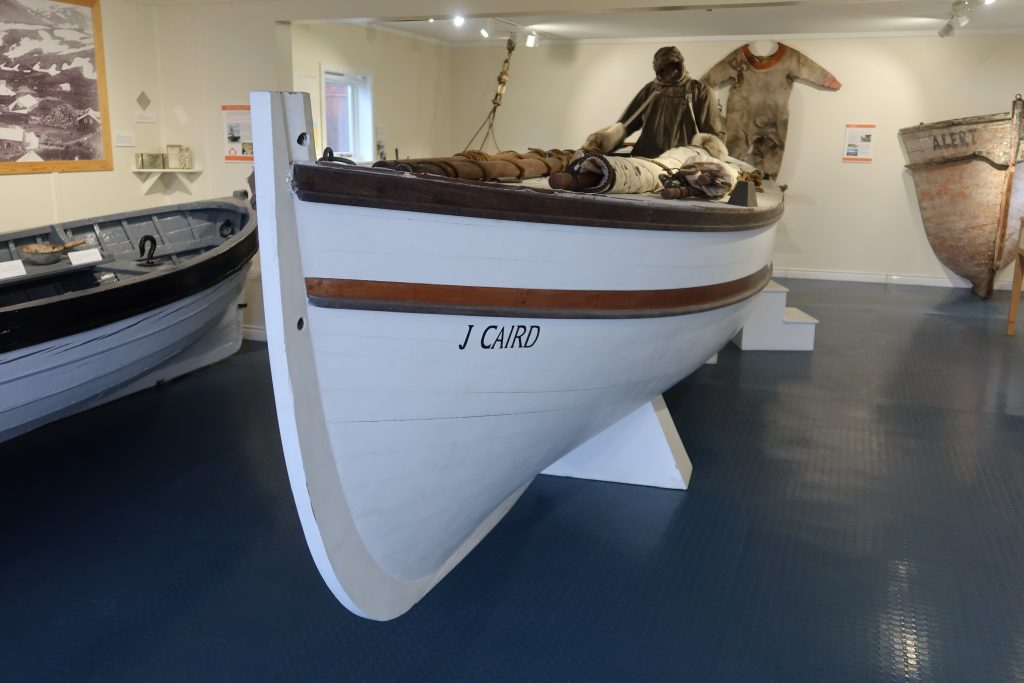
From the museum we headed up to the church. This was pre-fabricated in Norway and shipped out in the early days of the whaling station and became an important hub of the substantial community which built up around the processing plant. It was consecrated on Christmas Day in 1913 and funded by the whaling company. This was founded by a Norwegian – C.A.Larsen. He founded Grytviken in 1904 with the Compania Argentina de Pesca and eventually took on dual British and Norwegian nationality when the British realised that they needed to administer the island properly, having taken little interest in it until they realised its potential economic value.
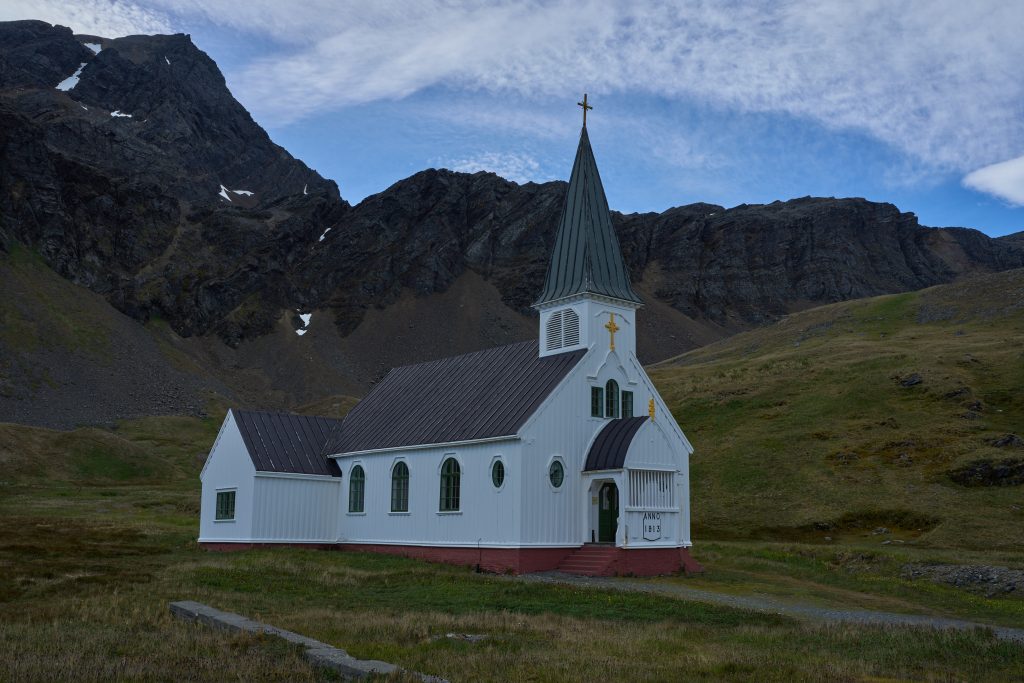
A visit to Shackleton’s grave was the obvious next step after running a gauntlet of various fur seals on the path to the cemetery. We have become expert at spotting the difference between fur seals and elephant seals as the elephant seals don’t care at all when you walk past. Very occasionally they might open their eyes, stretch and look at you, but even that seems more effort than it is worth so they usually just greet you with their trademark farting noise as they blow out through their nose and carry on with the strenuous activity of moulting. So, we always head closer to the elephant seals than the fur seals when walking past. Luckily for us Grytviken seems to have a larger population of elephant seals than a lot of the previous places. The grave itself stands out in the cemetery with a large headstone and is in a beautiful location. The other obvious grave there was of an Argentine submariner (from the Argentine submarine Santa Fe) from the 1982 conflict. South Georgia was effectively the starting point for the conflict and was retaken by SAS and SBS troops early on. The submariners grave had a new plaque on it to commemorate the 40th anniversary of the conflict.
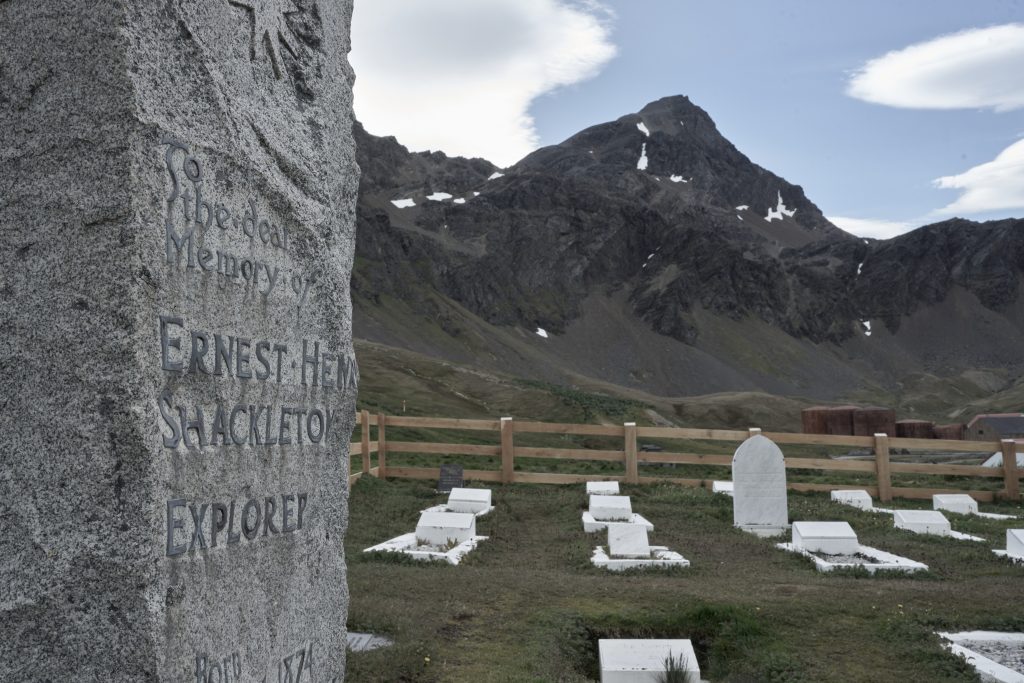
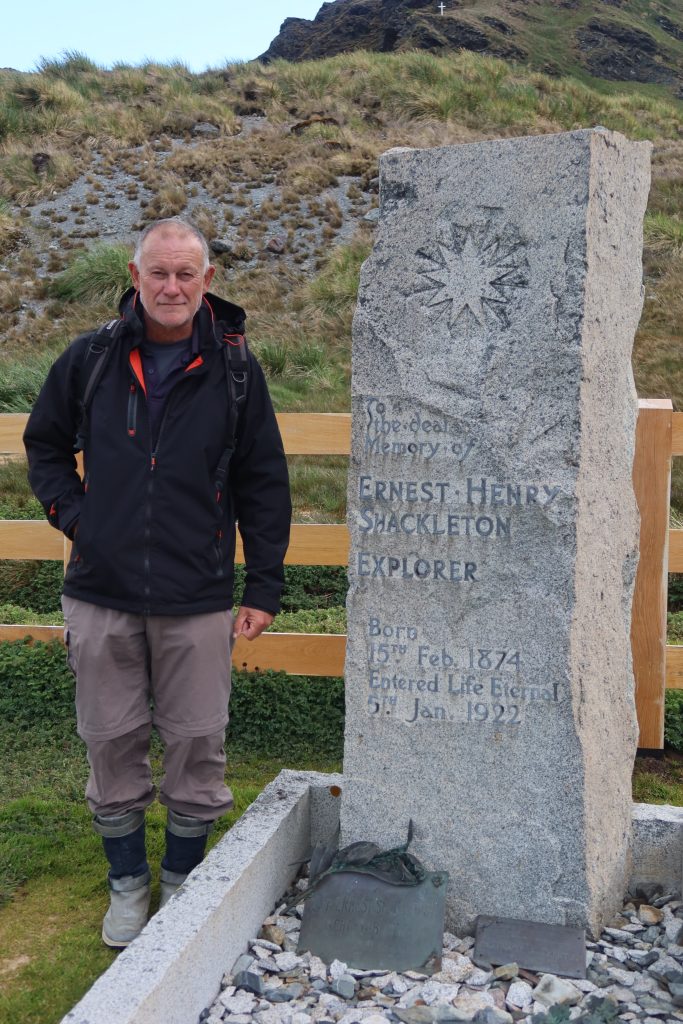
A wander along the foreshore takes you past the various elements of the whale processing plant, the centre of which was the Flensing Plan. This was a large rectangular wooden area where the whales were pulled onto by a steam powered winch for flensing; the process of cutting away the blubber. This was then taken into the various cookers and separating plants for final processing. They also produced bone meal for fertiliser and some of the meat was processed for animal feed. A gruesome process. One the foreshore are also the wrecks of three whale catching boats; the Dias, the Albatros and the Petrel. The Petrel was built in Norway in 1923 and was one of the first boats to have a catwalk. This was not for fashion shows, but a walkway so that the captain (who was usually the gunner as well) could run straight from the open bridge to the harpoon gun at the bow. Timing was everything with catching the whales and the whale catching boats could motor at around 17 or 18 knots to keep pace with the whales once they were spotted. The spotting was done from a crows nest at the top of the foremast; effectively just a barrel attached to the mast.
These three whale catchers became seal catching boats when whales were no longer economic and they finished their days in 1966 when the station was finally closed down. They were abandoned and the weight of snow on their decks eventually sank them. In 2003 they were all refloated and pulled ashore to what is now their final resting place; an eerie reminder of the industry they represented.
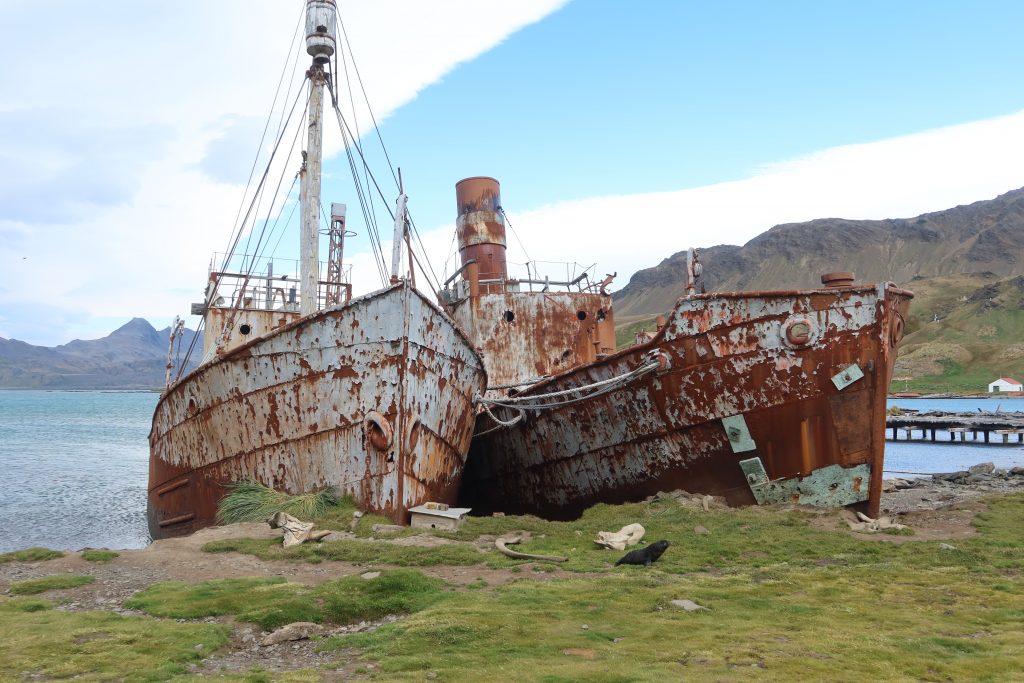
After a fascinating afternoon wandering around we headed back to the Tecla. The weather forecast is not too bad for heading to the Antarctic Peninsula, so although we had originally planned to stay another few days the decision has been made to head off this evening. With some nasty low pressure areas predicted in four or five days we want to get as far ahead of them as possible, so shortly after 6 o’clock we headed off again.
The marker to punctuate the other end of the day was whales again. A pod of humpbacks was feeding around us shortly after we left Grytviken and we regularly had to slow down to avoid them. They had other concerns than being run down by the Tecla and the main one was clearly krill and their stomachs! The best moment was when two dived almost right alongside the boat. A great end to the day.
